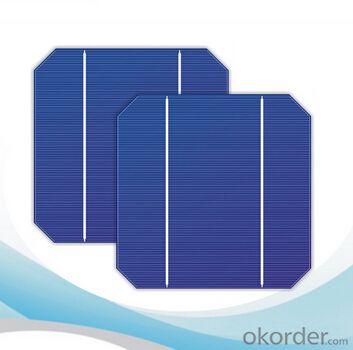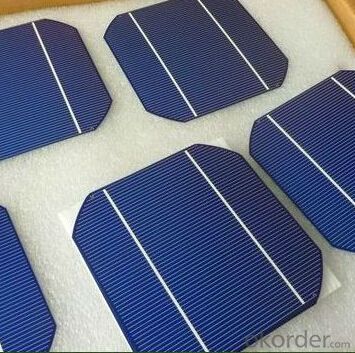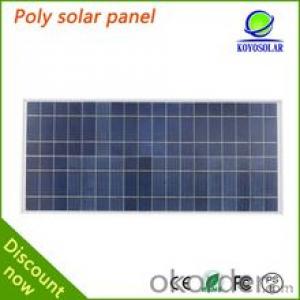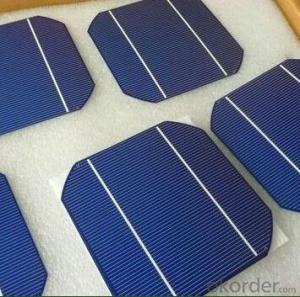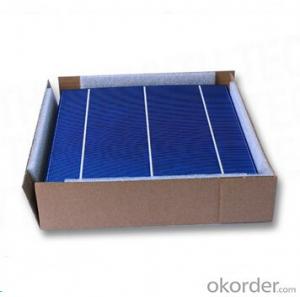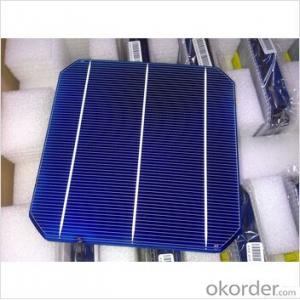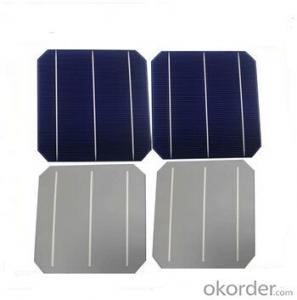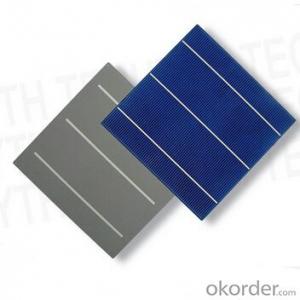Amorphous Solar Cells - High Quality Monocrystalline Solar Cells 16.25-18.00
- Loading Port:
- Shanghai
- Payment Terms:
- TT OR LC
- Min Order Qty:
- 1000 pc
- Supply Capability:
- 1000000 pc/month
OKorder Service Pledge
OKorder Financial Service
You Might Also Like
Solar Cells:
Solar cells is made by solar wafer, it has three categories of solar cell right now, monocrystalline polycrystalline and thin film,These cells are entirely based around the concept PN junction, which is the critical part of solar module, it is the part that can convert the light energy into electricity, the thickness is from 180um to 200um, with even busbars to conduct electricity, textured cell can decrease diffuse reflection; they are often electrically connected and encapsulated as a module. Photovoltaic modules often have a sheet of glass on the front (sun up) side, allowing light to pass while protecting semiconductor wafers from abrasion and impact due to wind-driven debris, rain, hail, etc. Solar cells are also usually connected in series in modules, creating an additive voltage. Connecting cells in parallel will yield a higher current;With high quality and stable quality. Our Cells can greatly improve the performance of Solar Modules.
Features:
1. High conversion efficiencies resulting in superior power output performance.
2. Outstanding power output even in low light or high temperature conditions
3. Optimized design for ease of soldering and lamination
4. Long-term stability, reliability and performance
5. Low breakage rate
6. Color uniformity
Solar Cells Advantage:
• High efficiency and stable performance in photovoltaic conversion.
• Advanced diffusion technique ensuring the homogeneity of energy conversion efficiency of the cell.
• Advanced PECVD film forming, providing a dark blue silicon nitride anti-reflection film of homogenous color and attractive appearance.
• High quality metal paste for back surface and electrode, ensuring good conductivity, high pulling strength and ease of soldering.
• High precision patterning using screen printing, ensuring accurate busbar location for ease with automatic soldering a laser cutting.
Specifications:
Product Mono-crystalline silicon solar cell
Dimension 156 mm x 156 mm ± 0.5 mm
Thickness 200 μm ± 30 μm
Front 1.5 ± 0.1 mm busbar (silver)
Silicon nitride antireflection coating
Back 3.0 mm continuous soldering pads (silver)
Back surface field (aluminum)
Size | 156mm x156mm ±0.5mm | |||||
Thickness | 190um ± 20um | |||||
Front surface(-) | 1.7mm bus bars(silver), blue anti-reflecting coating(Silicon nitride) | |||||
Back surface (+) | 3mm wide soldering pads(silver) back surface field(Aluminum) | |||||
TkVoltage | -0.346%/K | |||||
TkCurrent | +0.036%/K | |||||
TkPower | -0.47%/K | |||||
Efficiency(%) | Pmp(W) | Vmp(V) | Imp(A) | Voc(V) | Isc(A) | FF(%) |
17.75-18.00 | 4.27 | 0.527 | 8.102 | 0.628 | 8.615 | 78.90 |
17.50-17.75 | 4.21 | 0.521 | 8.083 | 0.627 | 8.584 | 78.23 |
17.25-17.50 | 4.15 | 0.517 | 8.028 | 0.626 | 8.550 | 77.57 |
17.00-17.25 | 4.09 | 0.513 | 7.982 | 0.624 | 8.495 | 77.23 |
16.75-17.00 | 4.03 | 0.512 | 7.873 | 0.622 | 8.408 | 77.15 |
16.50-16.75 | 3.97 | 0.505 | 7.871 | 0.621 | 8.390 | 76.14 |
16.25-16.50 | 3.91 | 0.502 | 7.796 | 0.620 | 8.372 | 75.45 |
16.00-16.25 | 3.85 | 0.499 | 7.714 | 0.620 | 8.350 | 75.09 |
15.75-16.00 | 3.79 | 0.498 | 7.601 | 0.620 | 8.125 | 75.34 |
15.50-15.75 | 3.73 | 0.498 | 7.480 | 0.619 | 8.005 | 75.34 |
Packaging & Delivery of Solar Cells
Carton Box Package and Deliver by air. It should be noticed that it should be avoid of water, sunshine and moist.

FAQ
We have organized several common questions for our clients,may help you sincerely:
①What price for each watt?
It depends on the efficiency of the solar cell, quantity, delivery date and payment terms.
②How long can we receive the product after purchase?
In the purchase of product within three working days, We will arrange the factory delivery as soon as possible. The pecific time of receiving is related to the state and position of customers.Commonly 7 to 10 working days can be served.
③Can you provide the peripheral products of the solar panels, such as the battery, controller, and inverter? If so, can you tell me how do they match each other?
Yes, we can, we have two companies for solar region, one is CNBM International, the other is CNBM engineering Co.
We can provide you not only the solar module but also the off grid solar system, we can also provide you service with on grid plant.
④What is your warranty of solar cell?
Our product can promise lower than 0.3% open box crack, we support claim after opening the box if it has crackm color difference or sth, the buyer should give pictures immediately, we can not accept the claim after the solar cell has assembled to solar panel.
• Timeliness of delivery
• ⑤How do you pack your products?
We have rich experience on how to pack the solar cell to make sure the safety on shipment, we could use wooden box or pallet as buyer's preference.
- Q: How can the solar power change our life by using solar cells material?
- Because solar power is basically cost-saving compared to the other traditional power/energy generation method.
- Q: How much maintenance do solar cells require?
- Solar cells require very little maintenance. They are designed to be durable and can last for several decades with minimal upkeep. Routine maintenance typically involves cleaning the surface of the solar panels to ensure optimal sunlight absorption and occasionally checking for any damage or debris. Overall, solar cells are a low-maintenance energy solution.
- Q: What is the maximum temperature a solar cell can withstand?
- The maximum temperature a solar cell can withstand varies depending on the specific type and design of the cell. However, most solar cells can typically withstand temperatures up to around 85-90 degrees Celsius (185-194 degrees Fahrenheit) without significant degradation in performance.
- Q: How are solar cells affected by temperature?
- Solar cells are negatively affected by high temperatures, as they can cause a decrease in efficiency and overall performance. The increase in temperature can lead to an increase in resistance, which reduces the flow of electric current within the cell. This decrease in current output results in a decrease in power generation. Additionally, high temperatures can accelerate the degradation of the materials used in solar cells, reducing their lifespan. However, low temperatures can have a positive effect on solar cell performance, as they can increase the efficiency and power output.
- Q: What is the impact of temperature fluctuations on solar cell efficiency?
- Temperature fluctuations can have a significant impact on solar cell efficiency. As temperature increases, the efficiency of solar cells tends to decrease. This is because higher temperatures can cause an increase in the resistance of the materials used in solar cells, leading to a decrease in the overall power output. Additionally, temperature fluctuations can also lead to thermal stress and expansion, which can potentially damage the solar cells and further reduce their efficiency. Therefore, it is important to consider and manage temperature fluctuations to optimize the performance of solar panels.
- Q: Is it possible to learn how to make solar cells by yourself?
- I don't know how to make a solar cell by myself, but I am very interested in your trying to do it.
- Q: What is the role of solar cells in powering electric fences?
- Solar cells play a crucial role in powering electric fences as they convert sunlight into electrical energy, which is then used to charge the batteries that supply power to the fence. This renewable energy source ensures a consistent and sustainable power supply, eliminating the need for traditional power sources or frequent battery replacements.
- Q: How do solar cells affect property value?
- Solar cells can positively affect property value by reducing energy costs, increasing energy efficiency, and providing a sustainable and environmentally friendly energy source. Additionally, solar panels can be seen as a desirable feature by potential buyers, leading to increased demand and higher property values.
- Q: What is the current situation and the recent progress space solar cells in China?
- Because the power supply system is one of the important subsystems of the satellites, they need to be configured with a suitable, reliable power subsystem. The proportion of the power subsystem in the whole satellite system is the highest, so the research on the power supply system is very important.
- Q: Can solar cells be used for desalination purposes?
- Yes, solar cells can be used for desalination purposes. Solar-powered desalination systems, such as solar stills and solar desalination plants, harness the energy from the sun to power the desalination process. This renewable energy source helps reduce the environmental impact of desalination and promotes sustainable water production.
Send your message to us
Amorphous Solar Cells - High Quality Monocrystalline Solar Cells 16.25-18.00
- Loading Port:
- Shanghai
- Payment Terms:
- TT OR LC
- Min Order Qty:
- 1000 pc
- Supply Capability:
- 1000000 pc/month
OKorder Service Pledge
OKorder Financial Service
Similar products
Hot products
Hot Searches
Related keywords
